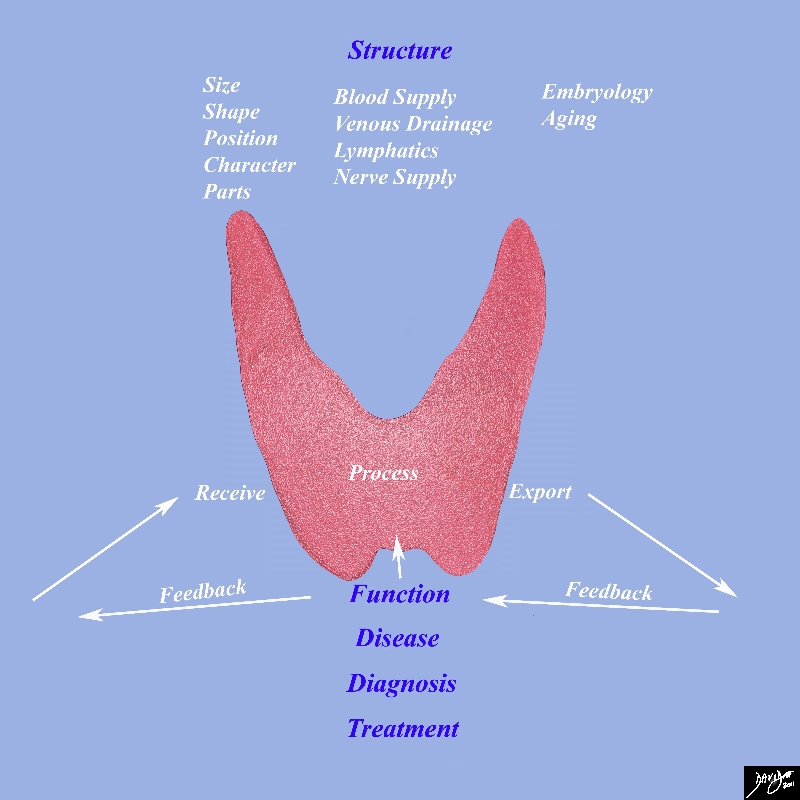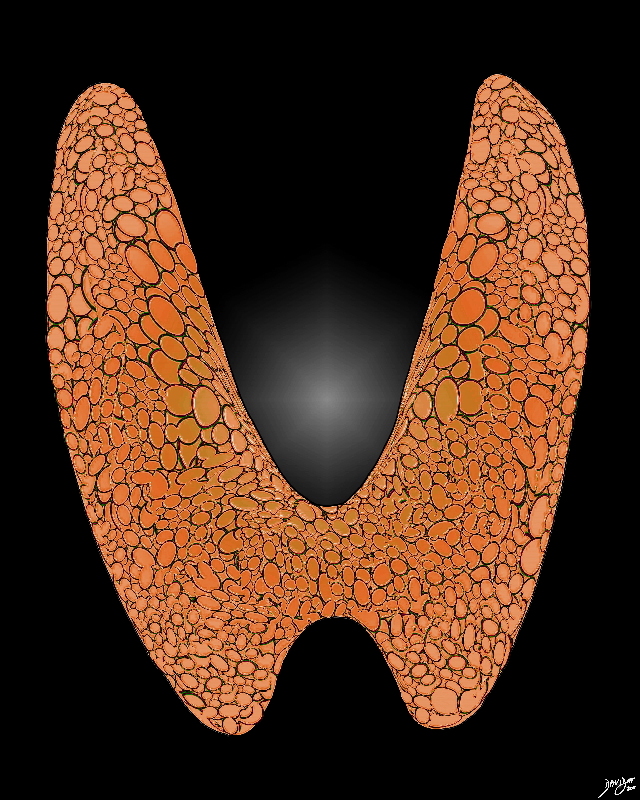The Common Vein Copyright 2010
Principles of the Thyroid – How is it the same and how is it different?
As Biological Unit
The thyroid, like any organ, is simultaneously a distinct biological unit, the sum of many smaller biological units, but also part of a larger physiological whole. As such, it is an indispensable component of the endocrine system and the body.
|
The Thyroid Gland – Unique in the Body |
|
The diagram frames the underlying principles and approach to the thyroid in this module with tenets that are common to all the organs and cells of the body. Its unique structure is defined by elements such as its size shape position, character and its parts. Its functions are based on its ability to receive and process a raw product, and produce and export a product that has value to the body. When there is disorder of structure and or function disease results and the role of medical disciplines is to diagnose and treat the disorders. Image Courtesy Ashley Davidoff MD copyright 2011 93852g05c.8s |
The elements of any organ are rooted in its structure and function, and the module defines the principle elements that govern these two disciplines in the thyroid. Structure is described most commonly by the size shape position, character and parts of the organ and also by the elements that connect the organ to other structures including the blood vessels nerves and lymphatics. The function of an organ is rooted in its activity which is based on its ability to receive and process a raw product, and produce and export a product that has value to the body. There are mechanisms that control and fine tune supply and demand of the product.
When there is disease, structure and or function are disordered. Diagnosis is directed to the aberrant components of either the structure or function of the organ and treatment is directed at correcting the elements of structure or the function that are abnormal.
The thyroid is but one part of the endocrine system, yet a very central one. Basal metabolic rate, the fire that keeps the body warm and functioning, is an essential component of body function. Without the thyroid, metabolism would be at a standstill. Fortunately its main function is executed through one type of hormone that can easily be replaced.
These principles are true to the thyroid and true to all the organs of the body. These principles are innately obvious but dogged attention to principles when issues become complex is key to solving the complex problems. The “devil” therefore from this vantage point is in the principles and also of course in the “detail”.
|
Artistic Rendition Showing the Combined Macroscopic and Microscopic Features |
|
The normal gland has a unique appearance both macroscopically and microscopically. Its name implies a shield like shape, and it mirrors the shape of the thyroid cartilage. It is brownish red in color and at a histological level is made of variably sized rounded glandular rosettes with spaces that contain colloid in which thyroglobulin is stored. Thyroglobulin is a precursor of the thyroid hormones.. Storage of endocrine products outside of the cell is a unique feature of the thyroid gland. Courtesy Ashley Davidoff MD copyright 2010 all rights reserved 94460b13t06p04.81s |
Units to Unity
One cell is no cell, and one organ is no organ. This implies that although the individual parts are important, they are nothing unless they combine forces to form something bigger and more powerful than the individual parts.
The cells as separate biological units need to combine forces in order to produce hormones in sufficient quantity in order to be effective. A thyroid cell isolated in the abdominal cavity producing T3 has no functional effect, no matter how hard it works and no matter how talented it is. A genius artist painting in isolation that he or she puts in the closet has no value to the community, and as such cannot “sell” the “goods”, and as such cannot survive.
The organization of the cells into acini, groups of cells that are factories of production, allow the cells to build strength in numbers and cohesive effort. The factories of acini in turn need to combine forces to form lobules, and the lobules in turn need to form lobes and eventually form the organ that has the power of number to be effective. As each unit builds, the organization gets bigger and stronger and as long as everybody pulls their weight, and has their eye on the bigger picture (welfare of the body at large) health and orderly pleasurable living can proceed. One part of the puzzle still needs to be added however in order for this to work – links and connections of the organ to the bigger whole.
Links and Connections
The factories of production need to have input from the outside as to how hard to work, how much to produce and where and how to get the product to the end user. This is executed through connections to the transport systems including the circulatory and lymphatic systems but also the control systems that include endocrine and nervous systems. Circulatory connections deliver raw products, transport processed products, and remove waste. Hormonal connections via the neurohormonal axis of the pituitary and chemical receptors on and in the cells connect it to the chemical milieu of the body and allow the thyroid to have its finger on the pulse meeting supply with demand via feedback mechanisms.
Dependence and Independence
In summary the “units to unity” concept, together with the “links and connections” concept allow the thyroid to be unique in its own right, but allows it to participate in the bigger whole, fulfilling a function for the body at large and allowing it to be personally enriched by its contributions. This “independence dependence” balance is a key concept to all the biological units from each cell in the body to the societies in which we live. The “bill of rights” for the individual, “ask not what your country can do for you—ask what you can do for your country”, (Kennedy) and the “checks and balances” are statements that form the fabric of our society and apply equally to the organ and each cell.
Time Growth and Aging
Thyroid development begins in the fetus at three to four weeks of gestation. The precursors consisting of epithelial cells arise from endoderm proliferate from the base of the pharynx. From this moment, the cells of the thyroid are subjected to the forces of time. Over the next several weeks this cell mass migrates to the base of the neck. Shortly thereafter at eight weeks of gestation the pituitary begins to release thyroid stimulating hormone, prompting the thyroid to begin production of colloid and thyroxine by week ten. The responsibility of heating the home is assumed at this very young age of ten weeks.
The thyroid ages well, but function does decrease over time and often is the cause of morbidity in the elderly.
Space
The space assigned to the thyroid in the neck has no obvious rationale. It is a thermostat and for this it may be centrally located and near the brain – the main controlling centre of the body.
It lies on the anterior side of the neck against and around the trachea and extends posteriorly to the esophagus and carotid sheath. Longitudinally it stretches from just below the laryngeal prominence, or Adam’s apple, to the fifth or sixth tracheal ring. Owing to this position, any significant swelling of the thyroid, such as that caused by hyperthyroidism or iodine deficiency, is easily visible and palpable.
Forces
The forces that govern thyroid function are primarily chemical. Like most endocrine organs, the thyroid produces and releases hormones according to negative feedback inhibition loops. For example, low levels of thyroxine prompt the pituitary gland to release TSH. This, in turn, causes the thyroid to release thyroid hormones.. As the levels of thyroid hormone increase TSH is inhibited, which results in a decrease in thyroid hormone production. It is a continual balance of supply and demand and checks and balances.
The involvement of calcitonin abides by the same principles but relate specifically to calcium metabolism.
Thyroid function is also regulated by nervous pathways, specifically the sympathetic nervous system. The sympathetic system and thyroid have very similar effects on the body though the nervous system is more rapid in reacting while thyroid hormone is in the background and slower in response. It may be said that the sound one may hear at the height of the fight or flight response may be likened to a screech, while the sounds of the thyroid hormone may be likened to a hum.


